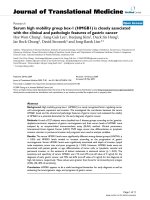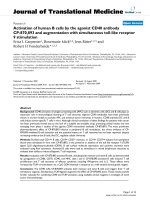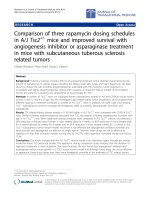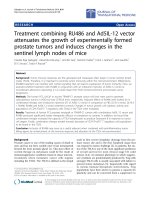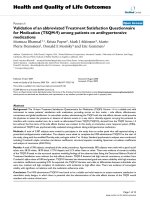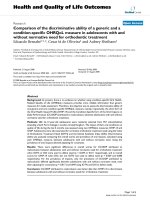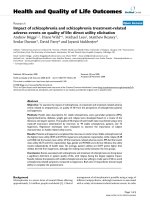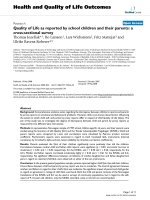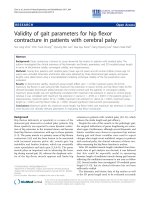báo cáo hóa học:" Treatment of stiff thoracic scoliosis by thoracoscopic anterior release combined with posterior instrumentation and fusion" potx
Bạn đang xem bản rút gọn của tài liệu. Xem và tải ngay bản đầy đủ của tài liệu tại đây (1.42 MB, 5 trang )
BioMed Central
Page 1 of 5
(page number not for citation purposes)
Journal of Orthopaedic Surgery and
Research
Open Access
Research article
Treatment of stiff thoracic scoliosis by thoracoscopic anterior
release combined with posterior instrumentation and fusion
Kenneth MC Cheung*
1
, Jing-ping Wu
2
, Qing-he Cheng
3
, Bonnie SC Ma
1
, Ji-
chang Gao
3
and Keith DK Luk
1
Address:
1
Department of Orthopedics and Traumatology, Queen Mary Hospital, The University of Hong Kong, 102 Pokfulam Road, Hong Kong,
China,
2
Department of Orthopaedics, Jinshan Hospital, Fudan University, Shanghai, China and
3
The 211th Hospital of PLA, Harbin, China
Email: Kenneth MC Cheung* - ; Jing-ping Wu - ; Qing-he Cheng - ;
Bonnie SC Ma - ; Ji-chang Gao - ; Keith DK Luk -
* Corresponding author
Abstract
Background: Thoracoscopic anterior release has been shown that it can effectively improve
spinal flexibility in animal and human cadaveric studies, and has been advocated for use in patients
with scoliosis. This prospective case series aims to investigate the improvement of the spinal
flexibility and the effectiveness in deformity correction by anterior thoracoscopic release and
posterior spinal fusion.
Methods: Eleven patients with stiff idiopathic thoracic scoliosis underwent anterior thoracoscopic
release followed by posterior instrumentation. The average number of discs excised was five. Spinal
flexibility was assessed by the fulcrum bending technique. Cobb angle before and after the anterior
release was compared.
Results: The patients were followed for an average of 5.6 years (range 2.2 to 8.1 years). Fulcrum
bending flexibility was increased from 39% before the thoracoscopic anterior spinal release to 54%
after the release. The average Cobb angle before anterior release was 74° on the standing
radiograph and 45° with the fulcrum-bending radiograph. This reduced to 34° on the fulcrum-
bending radiograph after the release, and highly corresponded to the 31° measured at the post-
operative standing radiograph.
Conclusion: It was demonstrated in patients with stiff idiopathic thoracic scoliosis that
thoracoscopic anterior spinal release can effectively improve the spinal flexibility and increase the
correction of the spinal deformity.
Background
Anterior spinal release can improve spinal flexibility and
maximize correction of spinal deformity effectively when
treating stiff thoracic scoliosis. It is inevitable to incise the
chest wall muscles to remove intervertebral disc in the
open chest procedures, which leads to multiple surgical
complications such as reduced airway flow, post-opera-
tive lung collapse, blood loss, chest wall scarring and pro-
longed hospitalization. Nevertheless, utilizing video-
assisted thoracoscopy in anterior spinal release can effec-
tively reduce or prevent these surgical complications [1,2].
Published: 15 October 2007
Journal of Orthopaedic Surgery and Research 2007, 2:16 doi:10.1186/1749-799X-2-16
Received: 23 January 2007
Accepted: 15 October 2007
This article is available from: />© 2007 Cheung et al; licensee BioMed Central Ltd.
This is an Open Access article distributed under the terms of the Creative Commons Attribution License ( />),
which permits unrestricted use, distribution, and reproduction in any medium, provided the original work is properly cited.
Journal of Orthopaedic Surgery and Research 2007, 2:16 />Page 2 of 5
(page number not for citation purposes)
Methodology
Between June 1997 and June 2003, 11 patients with stiff
thoracic scoliosis underwent thoracoscopic anterior
release, followed by either staged (one week apart) or syn-
chronous posterior instrumentation and spinal fusion.
Routine standing anterior-posterior radiograph was taken
for each patient to determine the Cobb angle (Figure 1).
Definition of stiff scoliosis is that the Cobb angle being
larger than 40 degrees in a fulcrum bending X-ray. The ful-
crum bending radiograph was taken with a cylindrical ful-
crum placed over the apex of the scoliotic curve (Figure 2,
3) [3]. The patient was asked to lie sideways over a ful-
crum made from a large plastic cylinder with extra pad-
ding for comfort, using the body weight of the head and
lower limbs to straighten the spine over the apex of the
convex curve. The mean age at the time of operation was
16.5 years (range 11.9 – 35.5 years). According to King's
classification, the curve types were as follows: type I (1),
type II (5), type III (5).
The surgical technique of thoracoscopic-assisted anterior
release was as described in the previous publication of Luk
et al. [2]. In brief, the thoracoscopic anterior release was
done under general anesthesia, a keyhole of 2 cm diame-
ter was opened over the mid-axillary line at the sixth or
seventh intercostal space at the convex side of the scoliotic
curve. 3 to 4 more manipulative keyholes were opened
near the mid-axillary line depending levels needed to be
exposed. Ribs were not removed. Intervertebral discs near
the apex were excised, including nucleus pulposus and
cartilaginous end-plates. The posterior longitudinal liga-
ment could be reached when excising the cephalic
intervertebral disc. In general, 3–6 intervertebral discs had
been excised and the average number of discs excised was
five. Posterior surgery adopted pedicle hook system, and
pedicle screws in the form of hybrid constructs were also
used in the later part of the study (Figure 4 &5, Table 1).
For King type I (double curve, lumbar major), both tho-
racic and lumbar curves were corrected and fused, while
for King type II and type III single thoracic curves, they
were selectively fused to the lower thoracic or upper lum-
bar spine.
Two methods were utilized to test for the effectiveness of
thoracoscopic anterior release in increasing spinal flexibil-
ity. First one was the direct comparison between the pre-
and post-operative angles in fulcrum bending radio-
graphs. Second one was comparing the pre-operative ful-
Fulcrum bending radiograph before anterior releaseFigure 2
Fulcrum bending radiograph before anterior release.
Standing radiograph before anterior releaseFigure 1
Standing radiograph before anterior release.
Journal of Orthopaedic Surgery and Research 2007, 2:16 />Page 3 of 5
(page number not for citation purposes)
crum bending radiograph with the post-operative
correction, using the fulcrum bending radiograph to
assess the spinal fulcrum bending flexibility. The fulcrum
bending flexibility was calculated as: Fulcrum Bending
Flexibility (%) = (Pre-operative Cobb Angle – Fulcrum
Bending Cobb Angle)/Pre-operative Cobb Angle × 100%.
This fulcrum bending flexibility can be used to assess the
change in spinal flexibility after anterior release. Statistical
analyses were performed using paired t-test, with p < 0.05
being statistically significant.
Results
All thoracoscopic anterior release surgeries were success-
fully done, none of the case was obliged to become open
surgery. Average time for anterior release was 4.3 hours
(range from 3 – 6 hours), and average blood loss was 180
ml (range from 40 – 400 ml). No obvious intra- or post-
operative complications. Mean follow-up length was 5.6
years (2.2 – 8.1 years). Pre-operative mean fulcrum bend-
ing flexibility was 39%, with a statistical significant incre-
ment (p < 0.05) of 15% after anterior release, the mean
fulcrum bending flexibility reached 54% post-operatively.
The mean Cobb angle in standing radiograph was 74
degree before anterior release, and that in fulcrum bend-
ing radiograph was 45 degree. After anterior release, how-
ever, the mean Cobb angle in fulcrum bending radiograph
was 34 degree. The actual mean Cobb angle in standing
radiograph after posterior instrumentation with bone
grafting was 31 degree (see table 2).
Discussion
Open chest surgery was adopted to improve the spinal
flexibility in stiff thoracic scoliosis. With the aid of video-
assisted thoracoscopic surgery (VATS), the traditional
open chest anterior release surgery could be replaced with
Standing radiograph after posterior instrumentationFigure 4
Standing radiograph after posterior instrumentation.
Fulcrum bending radiograph after anterior releaseFigure 3
Fulcrum bending radiograph after anterior release.
Journal of Orthopaedic Surgery and Research 2007, 2:16 />Page 4 of 5
(page number not for citation purposes)
micro-trauma and less complications [4-6]. While some
physicians thought thoracoscopic release and open chest
release have different abilities to release the spine, and
that only open chest surgery excising ribs and complete
excision of intervertebral discs could successfully and
completely release a stiff spine. VATS has been shown that
it can effectively improve spinal flexibility in animal and
human cadaveric studies [7]. Its use in human patients
with scoliosis have been supported by a number of studies
[8-10], however, all except one case report demonstrated
that it was effective at improving spinal flexibility.
In our study, stiff scoliosis curve was defined as the resid-
ual Cobb angle equal to or larger than 40 degrees in a ful-
crum bending radiograph. This concept of fulcrum
bending flexibility was first suggested and applied clini-
cally by the authors. It was used to select the fusion seg-
ments and predict the correction after surgery, so that
patients and their family could be informed the treatment
effect pre-operatively [11-14]. Previous researches showed
that this can reflect the spinal flexibility, comparison
between pre-operative fulcrum bending radiographs and
post-operative correction demonstrated 98% accuracy,
and the fulcrum bending flexibility can predict the post-
operative correction of rib hump accurately [13]. The ful-
crum bending flexibility applied in this study served as an
excellent method to judge the treatment effect of thoraco-
scopic anterior release. This cohort included 11 patients
with stiff thoracic scoliosis, with pre-operative fulcrum
bending Cobb angle larger than 40 degrees, and a mean of
45 degrees. The mean post-thoracoscopic fulcrum bend-
ing Cobb angle was 34 degrees, while the mean Cobb
angle in standing radiograph after posterior instrumenta-
tion was 31 degrees. These two were so close, and it dem-
onstrated that the pre-operative fulcrum bending
flexibility could accurately predict the result of surgical
correction. The side-bending radiographs taken in supine
lying could roughly predict the post-operatively correc-
tion, thus the fulcrum bending radiograph is superior to
the traditional side-bending radiograph to predict the
pos-operative Cobb angle.
Fulcrum bending flexibility is expressed as the difference
between the Cobb angles measured on the fulcrum bend-
ing and preoperative radiographs divided by the preoper-
ative Cobb angle [13]. In this series, the mean fulcrum
bending flexibility also improved from 39% pre-opera-
tively to 54% post-operatively, with 15% increment. This
is a strong evidence for thoracoscopic anterior release
could improve spinal flexibility among patients with stiff
thoracic scoliosis, so that the curves could be corrected.
When describing surgical correction, the authors would
propose that the spinal flexibility need to be taken into
account, and that this is best decribed by the fulcrum
bending correction index (FBCI). The FBCI is expressed as
correction rate divided by fulcrum flexibility; an FBCI of
100% indicates that the surgical correction has taken up
all the flexibility as revealed by the fulcrum bending radi-
ograph [13]. In this cohort, all patients had a FBCI of
Table 1: Number of patients with different instrumentations
Instrumentation
System
Number
of patients
Hooks only or hybrids
Isola 3 Hybrids
CD Horizon 4 Hook (1), Hybrids (3)
TSRH 1 Hook
Moss Miami 3 Hook (1), Hybrids (2)
Standing radiograph 5 years after surgeryFigure 5
Standing radiograph 5 years after surgery.
Journal of Orthopaedic Surgery and Research 2007, 2:16 />Page 5 of 5
(page number not for citation purposes)
larger than 100%, meaning anterior thoracoscopic release
with posterior spinal fusion could over-correct the stiff
scoliosis curves. In fact, previous study by the authors
demonstrated that ability to correct scoliosis deformity
using four different instrumentations was the same [15].
Due to inexperience at the beginning, only 3–4 interverte-
bral discs were excised during thoracoscopic anterior
release, and the posterior surgery was performed 1 week
later. It did, however, provide the conditions to prove the
effectiveness of anterior release, and verify the in vivo spi-
nal flexibility improvement with anterior release. With
increasing experience, 5–6 intervertebral discs were
excised in recent cases, and posterior instrumentation
with bone grafting could be done at the same stage. Ante-
rior release excised 5 intervertebral discs on average, with
mean improvement of 16 degrees, illustrated that excision
of a intervertebral disc could correct approximately 3
degrees. Although after excision of intervertebral discs, no
anterior bone grafting was performed, the follow-up radi-
ographs after 3 years revealed good fusion status, which
showed that solely posterior bone grafting could achieve
satisfactory fusion.
Competing interests
The author(s) declare that they have no competing inter-
ests.
Authors' contributions
KMCC participated in the design of the study and carried
out the thoracoscopic surgery. JPW assessed the radio-
graphic Cobb's angles and assisted in the surgery. QHC
performed the statistical analysis and helped to draft the
Chinese manuscript. BSCM drafted the manuscript. JCG
collected the data. KDKL conceived of the study, and par-
ticipated in the design of the study and coordination. All
authors read and approved the final manuscript.
Acknowledgements
Written consent for publication was obtained from the patient or their rel-
ative.
References
1. Anand N, Regan JJ: Video-assisted thoracoscopic surgery for
thoracic discdisease: Classification and outcome study of 100
consecutive cases with a 2-year minimum follow-up period.
Spine 2002, 27:871-879.
2. Luk KDK, Cheung KMC, Chiu SW: Thoracoscopic-assisted ante-
rior release of the spine. J Orthop Surgery 1996, 4:5-12.
3. Cheung KM, Luk KD: Prediction of correction of scoliosis with
use of the fulcrum bending radiograph. J Bone Joint Surg Am
1997, 79:1144-1150.
4. Kim DH, Jaikumar S, Kam AC: Minimally invasive spine instru-
mentation. Neurosurgery 2002, 51(5 Suppl):S15-S25.
5. Newton PO, Wenger DR, Mubarak SJ, Meyer RS: Anterior release
and fusion in pediatric spinal deformity. A comparison of
early outcome and cost of thoracoscopic and open thoracot-
omy approaches. Spine 1997, 22:1398-1406.
6. Niemeyer T, Freeman BJ, Grevitt MP, Webb JK: Anterior thoraco-
scopic surgery followed by posterior instrumentation and
fusion in spinal deformity. Eur Spine J 2000, 9:499-504.
7. Newton PO, Cardelia JM, Farnsworth CL, Baker KJ, Bronson DG: A
biomechanical comparison of open and thoracoscopic ante-
rior spinal release in a goat model. Spine 1998, 23:530-535.
8. Faro FD, Marks MC, Newton PO, Blanke K, Lenke LG: Periopera-
tive changes in pulmonary function after anterior scoliosis
instrumentation: thoracoscopic versus open approaches.
Spine 2005, 30:1058-1063.
9. Newton PO, Marks M, Faro F, Betz R, Clements D, Haher T, Lenke
L, Lowe T, Merola A, Wenger D: Use of video-assisted thoraco-
scopic surgery to reduce perioperatiev morbidity in scoliosis
surgery. Spine 2003, 28:s249-s254.
10. Qiu Y, Wu L, Wang B, Yu Y, Zhu ZZ, Qian BP: Thoracoscopic and
mini-open thoracotomic anterior correction for idiopathic
thoracic scoliosis: a comparison of their clinical results. Chin
J Surg 2004, 42:1284-1288.
11. Klepps SJ, Lenke LG, Bridwell KH, Bassett GS, Whorton J:
Prospec-
tive comparison of flexibility radiographs in adolescent idio-
pathic scoliosis. Spine 2001, 26:E74-79.
12. Luk KD: RE: Prospective comparison of flexibility radiographs
in adolescent idiopathic scoliosis. Spine 26: E74-9. Spine 2001,
26:2404.
13. Luk KD, Cheung KM, Lu DS, Leong JC: Assessment of scoliosis
correction inrelation to flexibility using the fulcrum bending
correction index. Spine 1998, 23:2303-2307.
14. Polly DW Jr, Sturm PF: Traction versus supine side bending.
Which techniquebest determines curve flexibility? Spine
1998, 23:804-808.
15. Luk KDK, Cheung KMC, Wong YW: A prospective comparison
of the coronal deformity correction in thoracic scoliosis
using four different instrumentations and the fulcrum-bend-
ing radiograph. Spine 2004, 29:560-563.
Table 2: Cobb angle measurements of all cases (°)
Case 1 Case 2 Case 3 Case 4 Case 5 Case 6 Case 7 Case 8 Case 9 Case 10 Case 11 Mean
Pre-operative Standing View 65 76 75 78 61 82 80 70 70 76 75 74
Pre-operative Fulcrum Bending View 43 41 45 45 40 46 45 53 44 45 51 45
Post-operative Fulcrum Bending View 35 28 40 30 N/A 34 32 36 30 34 40 34
Δ
Post-operative Standing View 32 28 30 28 26 29 28 33 22 32 35 31*
Correction Rate (%) 50.7 63.2 60 64.1 57.4 64.6 65 52.9 68.6 57.9 57.1 58.1
Fulcrum Flexibility (%) 46.2 63.2 46.7 61.5 N/A 58.5 60 48.6 57.1 55.3 50 57.1
FBCI (%) 109 100 128 104 N/A 110 108 109 120 105 114 102
Note 1: Compare with pre-operative fulcrum bending view
Δ
P < 0.05, * P < 0.05
Note 2: Unable to take post-operative fulcrum bending radiograph for case 5 due to post-operative wound pain

